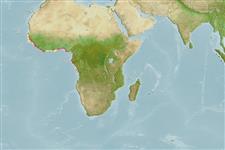>
Blenniiformes (Blennies) >
Blenniidae (Combtooth blennies) > Salariinae
Etymology: Hypleurochilus: Greek, hypo = under + Greek, pleura = in the side of + Greek, cheilos = lip.
More on author: Fowler.
Environment: milieu / climate zone / depth range / distribution range
экология
морской; солоноватоводный демерсальный. Tropical
Eastern Atlantic: northern Senegal to the mouth of the Congo (Ref. 4342, 81288). Also reported from Annobon Island (Ref. 5298).
Size / Вес / Возраст
Maturity: Lm ? range ? - ? cm
Max length : 8.3 cm TL самец/пол неопределен; (Ref. 81288)
колючие лучи спинного плавника (общее число): 12; членистые (мягкие) лучи спинного плавника (общее число): 14-17; колючие лучи анального плавника 2; членистые (мягкие) лучи анального плавника: 16 - 19. Diagnosis: length of supraorbital tentacles varies from approximately 2/3 of eye diameter to 2 times this diameter; longest tentacles occur in male specimens; shape of supraorbital tentacles varies from a single finger-like appendage bearing 2-4 filaments at the rear base to 4 appendages of almost equal length; anterior nostril forms a small tube which bears up to 4 cirri on posterior rim, only 1 in most cases; only one ring of cephalic sensory pores in infraorbital and preopercular series; lateral line does not reach beyond level of 8th-10th spine of dorsal fin; both males and females with a thin crest on head, but crest in females not as high as in males; dorsal fin with 12 spines and 14-17, generally 15-16, soft rays, last spine shorter than soft rays; anal fin with 2 spines and 16-19, generally 17-18, soft rays; caudal fin rounded (Ref. 81288).
Coloration: in alcohol, uniformly clear brown, lower part of head and throat clearer; some individuals with a black spot on membrane between 1st and 3rd dorsal spines; sometimes flanks bearing vertical stripes darker (Ref. 81288).
Euryhaline, entering mouth of large rivers and mangroves, but always in brackish water (Ref. 81288). Oviparous. Eggs are demersal and adhesive (Ref. 205), and are attached to the substrate via a filamentous, adhesive pad or pedestal (Ref. 94114). Larvae are planktonic, often found in shallow, coastal waters (Ref. 94114). Maximum SL recorded was 7.0 cm (Ref. 4342).
Life cycle and mating behavior
половая зрелость | размножение | нерест | икра | Fecundity | личинки
Oviparous, distinct pairing (Ref. 205).
Bath, H., 1986. Blenniidae. p. 355-357. In J. Daget, J.-P. Gosse and D.F.E. Thys van den Audenaerde (eds.) Check-list of the freshwater fishes of Africa (CLOFFA). ISNB, Brussels, MRAC, Tervuren; and ORSTOM, Paris. Vol. 2. (Ref. 4342)
Статус Красного Списка МСОП (Ref. 130435)
Угроза для людей
Harmless
Использование человеком
рыболовство: интереса не представляет
дополнительная информация
Возраст/РазмерыростЗависимость между длиной и массой телаЗависимость между длинамиРазмерный составморфометрияморфологияличинкидинамика численности личинокпополнениечисленностьBRUVS
ссылкиаквакультура (рыбоводство)особенности рыбоводствастепень растяжениягенетикаElectrophoresesнаследуемостьболезниобработкаNutrientsMass conversion
соавторыизображенияStamps, Coins Misc.звукиCiguateraскоростьтип плаванияжаберная областьOtolithsмозгзрение
инструменты
Специальные отчеты
Скачать в формате XML
ресурсы в Интернет
Estimates based on models
Preferred temperature (Ref.
123201): 25.2 - 28, mean 27.3 °C (based on 164 cells).
Phylogenetic diversity index (Ref.
82804): PD
50 = 0.5005 [Uniqueness, from 0.5 = low to 2.0 = high].
Bayesian length-weight: a=0.00741 (0.00335 - 0.01640), b=3.02 (2.83 - 3.21), in cm total length, based on LWR estimates for this (Sub)family-body shape (Ref.
93245).
Trophic level (Ref.
69278): 3.2 ±0.3 se; based on size and trophs of closest relatives
устойчивость к внешним воздействиям (Ref.
120179): высокий, минимальное время удвоения популяции до 15 месяцев (Preliminary K or Fecundity.).
Fishing Vulnerability (Ref.
59153): Low vulnerability (10 of 100).
